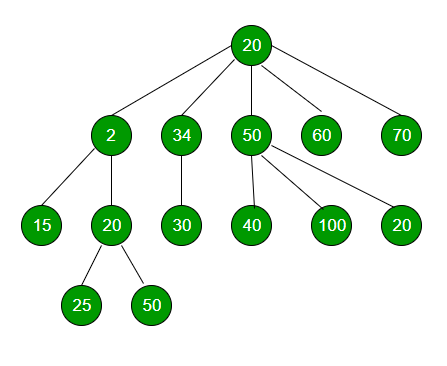给定一个N元树,找到其中的所有元素之和。

例子 :
Input : Above tree
Output : Sum is 536
方法:所使用的方法类似于二叉树中的“级别顺序”遍历。首先推送队列中的根节点。对于每个节点,将其从队列中弹出时,将该节点的值添加到sum变量中,然后将弹出元素的子级推入队列中。如果是通用树,则将子节点存储在向量中。因此,将向量的所有元素放入队列中。
下面是上述想法的实现:
C++
// C++ program to find sum of all
// elements in generic tree
#include
using namespace std;
// Represents a node of an n-ary tree
struct Node {
int key;
vector child;
};
// Utility function to create a new tree node
Node* newNode(int key)
{
Node* temp = new Node;
temp->key = key;
return temp;
}
// Function to compute the sum
// of all elements in generic tree
int sumNodes(Node* root)
{
// initialize the sum variable
int sum = 0;
if (root == NULL)
return 0;
// Creating a queue and pushing the root
queue q;
q.push(root);
while (!q.empty()) {
int n = q.size();
// If this node has children
while (n > 0) {
// Dequeue an item from queue and
// add it to variable "sum"
Node* p = q.front();
q.pop();
sum += p->key;
// Enqueue all children of the dequeued item
for (int i = 0; i < p->child.size(); i++)
q.push(p->child[i]);
n--;
}
}
return sum;
}
// Driver program
int main()
{
// Creating a generic tree
Node* root = newNode(20);
(root->child).push_back(newNode(2));
(root->child).push_back(newNode(34));
(root->child).push_back(newNode(50));
(root->child).push_back(newNode(60));
(root->child).push_back(newNode(70));
(root->child[0]->child).push_back(newNode(15));
(root->child[0]->child).push_back(newNode(20));
(root->child[1]->child).push_back(newNode(30));
(root->child[2]->child).push_back(newNode(40));
(root->child[2]->child).push_back(newNode(100));
(root->child[2]->child).push_back(newNode(20));
(root->child[0]->child[1]->child).push_back(newNode(25));
(root->child[0]->child[1]->child).push_back(newNode(50));
cout << sumNodes(root) << endl;
return 0;
} Java
// Java program to find sum of all
// elements in generic tree
import java.util.*;
class GFG
{
// Represents a node of an n-ary tree
static class Node
{
int key;
Vector child;
};
// Utility function to create a new tree node
static Node newNode(int key)
{
Node temp = new Node();
temp.key = key;
temp.child = new Vector<>();
return temp;
}
// Function to compute the sum
// of all elements in generic tree
static int sumNodes(Node root)
{
// initialize the sum variable
int sum = 0;
if (root == null)
return 0;
// Creating a queue and pushing the root
Queue q = new LinkedList<>();
q.add(root);
while (!q.isEmpty())
{
int n = q.size();
// If this node has children
while (n > 0)
{
// Dequeue an item from queue and
// add it to variable "sum"
Node p = q.peek();
q.remove();
sum += p.key;
// Enqueue all children of the dequeued item
for (int i = 0; i < p.child.size(); i++)
q.add(p.child.get(i));
n--;
}
}
return sum;
}
// Driver program
public static void main(String[] args)
{
// Creating a generic tree
Node root = newNode(20);
(root.child).add(newNode(2));
(root.child).add(newNode(34));
(root.child).add(newNode(50));
(root.child).add(newNode(60));
(root.child).add(newNode(70));
(root.child.get(0).child).add(newNode(15));
(root.child.get(0).child).add(newNode(20));
(root.child.get(1).child).add(newNode(30));
(root.child.get(2).child).add(newNode(40));
(root.child.get(2).child).add(newNode(100));
(root.child.get(2).child).add(newNode(20));
(root.child.get(0).child.get(1).child).add(newNode(25));
(root.child.get(0).child.get(1).child).add(newNode(50));
System.out.print(sumNodes(root) +"\n");
}
}
// This code is contributed by 29AjayKumar C#
// C# program to find sum of all
// elements in generic tree
using System;
using System.Collections.Generic;
class GFG
{
// Represents a node of an n-ary tree
class Node
{
public int key;
public List child;
};
// Utility function to create a new tree node
static Node newNode(int key)
{
Node temp = new Node();
temp.key = key;
temp.child = new List();
return temp;
}
// Function to compute the sum
// of all elements in generic tree
static int sumNodes(Node root)
{
// initialize the sum variable
int sum = 0;
if (root == null)
return 0;
// Creating a queue and pushing the root
Queue q = new Queue();
q.Enqueue(root);
while (q.Count != 0)
{
int n = q.Count;
// If this node has children
while (n > 0)
{
// Dequeue an item from queue and
// add it to variable "sum"
Node p = q.Peek();
q.Dequeue();
sum += p.key;
// Enqueue all children of the dequeued item
for (int i = 0; i < p.child.Count; i++)
q.Enqueue(p.child[i]);
n--;
}
}
return sum;
}
// Driver program
public static void Main(String[] args)
{
// Creating a generic tree
Node root = newNode(20);
(root.child).Add(newNode(2));
(root.child).Add(newNode(34));
(root.child).Add(newNode(50));
(root.child).Add(newNode(60));
(root.child).Add(newNode(70));
(root.child[0].child).Add(newNode(15));
(root.child[0].child).Add(newNode(20));
(root.child[1].child).Add(newNode(30));
(root.child[2].child).Add(newNode(40));
(root.child[2].child).Add(newNode(100));
(root.child[2].child).Add(newNode(20));
(root.child[0].child[1].child).Add(newNode(25));
(root.child[0].child[1].child).Add(newNode(50));
Console.Write(sumNodes(root) +"\n");
}
}
// This code is contributed by PrinciRaj1992 输出:
536
时间复杂度: O(N),其中N是树中的节点数。
辅助空间: O(N),其中N是树中的节点数。